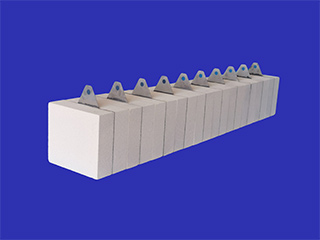The Best Solution For Your Specific Needs
The Best Solution For Your Specific Needs
 Tel: +86-532-85717690/85717352/85832089
Tel: +86-532-85717690/85717352/85832089 E-mail: wam@wamcn.net
E-mail: wam@wamcn.net
Fire bricks, also known as refractory bricks, are specially designed bricks that can withstand high temperatures without getting damaged or losing their structural integrity. On the other hand, regular bricks are commonly used for construction purposes and are not as heat resistant as fire bricks. In this article, we will explore the differences between fire bricks and regular bricks, highlighting their unique properties and applications.

Fire bricks are primarily made of refractory ceramic materials, such as clay, silica, alumina, and magnesia. These materials have a high melting point and are resistant to thermal shock, making them ideal for use in furnaces, kilns, and fireplaces. Fire bricks have a low thermal conductivity, which means they can effectively insulate heat and prevent it from escaping the enclosed area. They are also dense and have a high compressive strength, providing excellent structural stability in high-temperature environments.
Regular bricks, on the other hand, are typically made of clay and shale. While they are durable and suitable for construction projects, they lack the heat-resistant properties of fire bricks. Regular bricks have higher thermal conductivity, which means they may absorb and transmit heat more easily. Therefore, they are not suitable for applications that require heat resistance, such as lining fireplaces or furnaces.
Fire bricks find extensive use in industries that involve high-temperature processes. They are commonly used in the construction of furnaces, kilns, and ovens, where they form the inner lining to protect against extreme heat. Fire bricks are also used in the construction of fireplaces and chimneys, as they can withstand the intense heat generated by the combustion of wood or other fuels.
Regular bricks, being less heat resistant, are primarily used in general construction, such as building walls, foundations, and pavements. They provide structural support and are ideal for creating load-bearing walls. Regular bricks are widely available and cost-effective, making them a popular choice in the construction industry.
Fire bricks are specialized products with specific heat-resistant properties. As a result, they are comparatively more expensive than regular bricks. The manufacturing process of fire bricks involves high-temperature firing and the use of refractory materials, which adds to their production costs. Additionally, fire bricks are not as commonly available as regular bricks, and their purchase may require sourcing from specialized suppliers.
Regular bricks, on the other hand, are widely produced and readily available in various grades and sizes. They are relatively more affordable due to their mass production and widespread use. Regular bricks can be easily obtained from local hardware stores, making them a convenient choice for construction projects.
In conclusion, fire bricks and regular bricks differ in composition, properties, applications, and cost. Fire bricks are designed to withstand high temperatures and provide thermal insulation, making them suitable for use in industries involving extreme heat. Regular bricks, while durable, lack the heat-resistant properties of fire bricks and are primarily used in general construction. Understanding the unique characteristics of each type of brick enables us to make informed decisions when choosing the right material for specific applications.